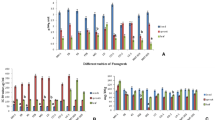Abstract
In this study the milling and baking characteristics of ten strains of spelt wheat (Triticum aestivum ssp. spelta) originated from Polish breeding were shown. Evaluation of the grain included test weight, vitreousness and hardness. White spelt flour with extraction rate of 65–70% was characterized through the analyses of ash, protein, wet gluten and starch contents as well as Farinograph test, Amylograph test and falling number. Most of spelt wheat varieties investigated demonstrated good milling properties and high baking quality. The spelt breads were analyzed for their potential beneficial components, including total phenolic compounds (TPC) and flavonoids (TF), tocopherols (T) and tocotrienols (T3), inositol phosphates (IP) and reduced (GSH) and oxidized (GSSG) glutathione, and then compared to commercial wheat roll based on wheat flour with extraction rate of approximately 70%. The comparison of the bioactive compounds content between spelt breads and wheat showed a similar level of TPC, TF and GSH. The tocopherols and tocotrienols content in spelt bread was about twice lower when compared to wheat roll. Moreover, spelt wheat bread formulated from flour originated from STH 915 strain showed higher content of inositol phosphates when compared to wheat roll and to those breads from flour of STH 975 and STH 974 strains.



Similar content being viewed by others
References
Bonafaccia G, Galli V, Francisci R, Mair V, Skrabanja V, Kreft I (2000) Food Chem 68:437–441
Ranhotra GS, Gelroth JA, Glaser BK, Lorenz KJ (1995) Lebensm-Wiss. u-Technol 28:118–122
Podbiełkowski Z (1985) Słownik roślin użytkowych PWRiL, Warszawa, pp 301–302
Ceglińska A (2003) Electronic Journal of Polish Agricultural Universities, Food Science and Technology, vol. 6, Issue 1
Tyburski J, Żuk-Gołaszewska (2005) Postępy Nauk Rolniczych 4:3–13
Strechlow W, Hertzka G, Wueffen W (1991) The dietary properties of spelt in the treatment of chronical diseases. Proceeding 2, Hohenheimer Dinkelkolloquium Verlag, Stuttgart, 243–259
Hertzka G, Strechlow W (1988) Handbuch der Hildegard—Medizin, Nr. 4. Der Dinkel als Heilmittel. Freiburg, Germany, Bauer Verlag, pp 4–8
Portman ML (1991) Hildegard von Bingen, Heilkraft der Natur‚ Physica’. Dinkel Pattloch Verlag, Augsburg, Germany, pp 45–48
Forssell F, Wieser H (1995) Eur Food Res Technol 201:35–39
Kasadra DD, D’Ovidio P (1999) Cereal Chem 76:548–551
Adams JF, Engstrom A (2000) Cereal Foods World 45:75–78
Zieliński H (2002) Pol J Food Nutr Sci 11/52:3–9
Andlauer W, Furst P (1998) Cereal Foods World 43:356–360
Zieliński H, Honke J, Troszyńska A, Kozłowska H (1999) Cereal Chem 76:944–948
Grela E, Matras J, Kling ChI, (1993) Biul Inf Przem Pasz 4:35–44
Ranhotra GS, Gelroth JA, Glaser BK, Lorenz KJ (1996) J Food Comp Anal 9:81–84
Grela ER (1996) J Sci Food Agric 71:399–404
Moundry J, Dvoracek V (1999) Rostl Vyr 45:533–538
AACC (2000) Approved methods of the American association of cereal chemists, 10th edn. St. Paul (Minnesota). American association of cereal chemists Inc
Sitkowski T (1998) Przegl Zboż-Młyn 42(5):8–11
Peterson DM, Qureshi AA (1993) Cereal Chem 70(2):157–162
Shahidi F, Naczk M (1995) In: Shahidi F, Naczk M (eds) Food phenolic: sources, Chemistry, effects and applications. Technomic Publishing Company, Lancaster, pp 287–293
Jia Z, Tang M, Wu J (1998) Food Chem 64:555–559
Smith IK, Vierheller TL, Thorne CA (1988) Anal Biochem 175:408–413
Hissin J, Hilf R (1976) Anal Biochem 74:214–226
Honke J, Zieliński H, Troszyńska A, Kozłowska H (2000) Czech J Food Sci 18:251–253
Sandberg AS, Ahderinne R (1986) J Food Sci 51:547–550
Abdel-Aal E-SM, Hucl P, Sosulski W, Bhirud PR (1997) J Cereal Sci 26:363–370
Schober TJ, Clarke CI, Kuhn M (2002) Cereal Chem 79:408–417
Andlander W, Furst P (1999) Cereal Food World 44(2):76–78
Andlauer W, Furst P (1998) Cereal Foods World 43:356–360
Shamsuddin AM (1995) J Nutr 125:725–732
Somasundar P, Riggs DR, Jackson BJ, Cunningham CC, Vona-Davis L, McFadden DW (2005) J Surg Res 126:199–203
Phillippy BQ, Graf E (1997) Free Radic Biol Med 22(6):939–946
Zieliński H, Kozłowska H, Lewczuk B (2001) Inn Food Sci Emerg Technol 2/3:159–169
Flag EW, Coates RJ, Eley JW, Jones DP (1994) Nutr Cancer 21(1):33–46
Shan XQ, Aw TY, Jones DP (1990) Pharmacol Ther 47(1):61–71
Valencia E, Marin A, Hardy G (2001) Nutrition 17:783–784
Li W, Bollecker SS, Schofield JD (2005) J Cereal Sci 39:205–212
Schofield JD, Chen X (1995) J Cereal Sci 21:127–136
Dong W, Hoseney RC (1995) Cereal Chem 72:58–64
Dreese PC, Faubion JM, Hoseney RC (1988) Cereal Chem 65:354–359
Zieliński H, Rzedzicki Z (2001) J Food Process Preserv 25:197–206
Acknowledgments
The work was funded in part by research grant No. PBZ-KBN-094/P06/2003/13 from the Polish State Committee for Scientific Research and statutory funds of the Department of Food Technology of the Institute of Animal Reproduction and Food Research of Polish Academy of Sciences. This article is a part of the Ph.D. thesis of A. Michalska.
Author information
Authors and Affiliations
Corresponding author
Rights and permissions
About this article
Cite this article
Zieliński, H., Ceglińska, A. & Michalska, A. Bioactive compounds in spelt bread. Eur Food Res Technol 226, 537–544 (2008). https://doi.org/10.1007/s00217-007-0568-1
Received:
Revised:
Accepted:
Published:
Issue Date:
DOI: https://doi.org/10.1007/s00217-007-0568-1




